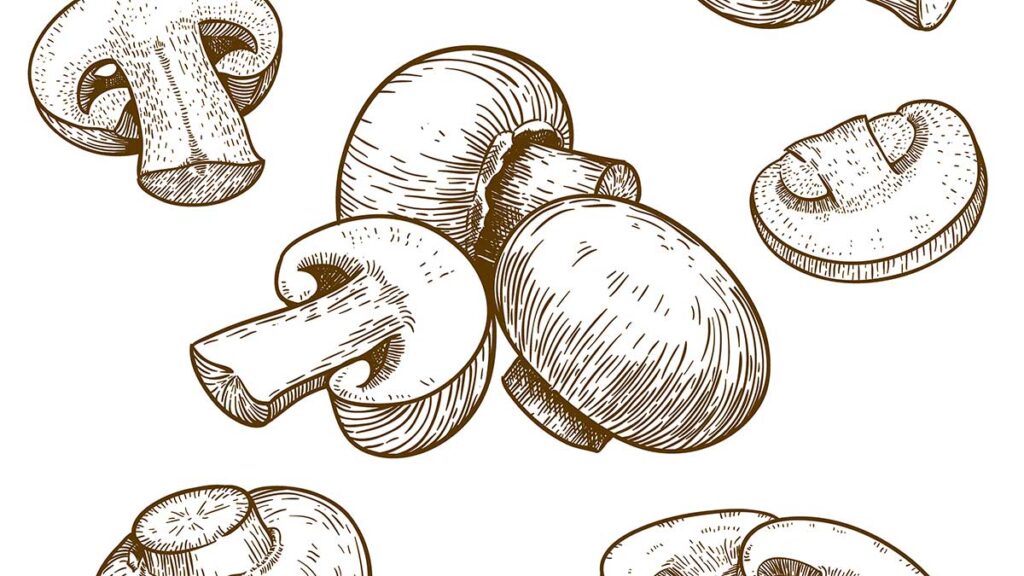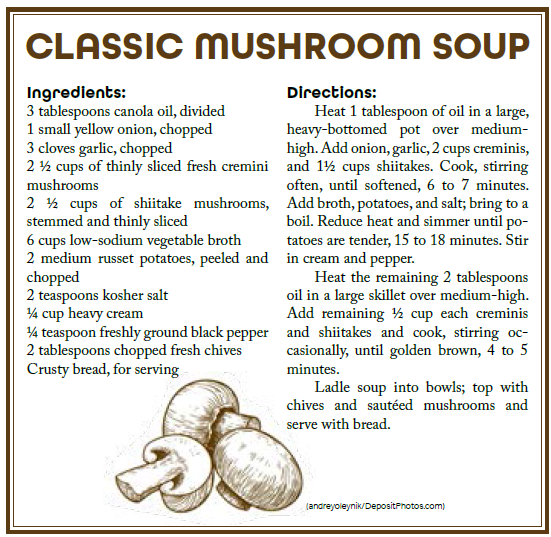
Mushrooms have a robust unique flavor called umami, (pronounced oo-MAH-mee), which many consider the fifth basic taste, alongside sweet, sour, salty, and bitter. Umami, which is Japanese for “pleasant savory taste” or “yummy” was identified by Japanese chemist Kikunae Ikeda in the 1900s.
While eating seaweed soup, he noticed that the taste could not be described as one of the four taste categories. With his science background, he found out exactly what this “umami” flavor was. Technically, umami refers to glutamate which is a type of amino acid which is naturally found in numerous foods. When glutamate ferments, it becomes L-glutamate, described as a savory, brothy, rich, or meaty taste sensation.
Why is umami important? First, the more umami in food, the more ßavorful it will be. Secondly, umami creates both appetite appeal and satiety. Next, umami counterbalances saltiness and allows 50 % salt reduction without compromising ßavor. And finally, umami brings out the best flavors by highlighting sweetness and lessening bitterness.
All mushrooms are a rich source of umami; the darker the mushroom, the more umami it contains. These are widely available mushrooms with the most umami: Shiitake, Portabella, Crimini, and White Button.
Dried mushrooms have more umami than fresh ones, and cooked mushrooms are more umami-rich than raw. Adding mushrooms in virtually any form, raw, sautŽed, or whole cap garnish, will add an umami boost to foods.
The following mushrooms are common varieties found in grocery stores.
Beech brown | Beech Brown is considered one of the most gourmet mushrooms due to its rich flavor, consisting of a mild, sweet, nutty taste with a firm texture.
Maitake | They are also gorgeous and delicious, often called ‘hen of the woods’ with their wild, feathery look with fan-like caps. They have a rich, woodsy taste, perfect for grilling or broiling. Maitake can be sautŽed in butter or oil or used as the main ingredient of side dishes and soups.
Shiitake | Shiitake, with its ivory-colored stem and a dark brown cap, contains many of the same protein-building blocks as meat and is an excellent meat alternative. Shiitakes add a meaty flavor and texture to stir-fries, pasta, soups, entrees, and sides.
Lion’s mane | These puffball-shaped mushrooms have a spongy texture and taste incredible when grilled. Lion’s Mane is similar to crab or lobster; when cooked, the mushrooms are slightly chewy, tender, and juicy. Try sautŽing in a hot skillet until water releases and edges brown, then add butter and seasonings. These are delicious with vegetables and stir-fries.
Chanterelle | These long-stemmed mushrooms shaped like a trumpet contain decent doses of immunity-supporting vitamin D and are incredibly delicious sautŽed simply in butter and seasoned with salt and pepper.
White button | The white button supermarket staple has a mild flavor that blends well with most ingredients. SautŽ or cook almost any way or eat raw. Try white buttons sliced and sautŽed on pizza, pasta, quesadillas, or cheeseburgers.
Button is the most common, mildest tasting mushroom. About 90% of mushrooms consumed are this variety. They are an all-purpose mushroom that is good eaten raw on salads, sautŽed, and served with beef, pizza, or purŽed into soups.
Portobello | Portobello mushrooms are one of the most consumed mushrooms. They make an excellent substitute for meat as they have a deep meat-like texture and flavor. Whether grilled, broiled, or roasted, the portobello mushroom is tasty. Swap grilled portobello mushrooms for hamburgers, chop them up, and add beef to a favorite stroganoff recipe.
Oyster | Oyster, whitish and fan-shaped, has a very delicate taste and scent. They have a smooth oyster-like texture and a slight seafood-like flavor when cooked. Flavors are subtle but have an anise flavor with a mild earthy note. They are best in stir-fries, soups, or when sautŽed with butter and onions. Try adding oyster mushrooms over linguine with sliced steak and sprinkled with grated Parmesan cheese.
Trumpet | Trumpet, a type of oyster mushroom, is thick and stumpy with small flat caps. They are popular in Asian cooking and used in soups and stir-fries. When eaten raw, they have little to no flavor, but when cooked, they have an umami taste and a flavor and texture compared to an abalone. They have a crunchy and firm texture.
Cremini | Firm and dark, cremini (baby bella) mushrooms provide a fantastic, nuanced flavor deeper and earthier than white buttons. They are yummy when roasted with olive oil and fresh herbs. The hearty, earthy, full-bodied taste of cremini mushrooms makes them an excellent addition to beef, wild game, and vegetable dishes.
Mushrooms are versatile ingredients giving our foods a unique flavor. We can eat them in a sandwich, mix them into soups and salads or even substitute them for meat. According to the Agricultural Marketing Resource Center, the average American eats nearly three pounds of mushrooms a year. Celebrate mushrooms by expanding our culinary palate by picking up varieties of mushrooms that we never tried before. Abundant types are available through the supermarket, at farmer’s markets, and even in specialty stores.
Few simple recipes are as satisfying as a classic mushroom soup. This is because mushrooms are high in umami, the “fifth taste,” which roughly translates to savory. This easy version calls for cremini and shiitake mushrooms, both of which have deep, earthy notes.
Nancy J. Schaaf is a retired English/literature educator and also a retired nurse.


Let's keep in touch!
Keep up with the latest OutLook by the Bay information by signing up here. We promise not to waste your time.

